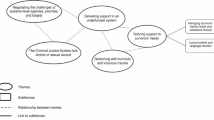Abstract
In order to combat sexual violence and better respond to victims of sexual assault, some jurisdictions have taken steps, including the creation of Sexual Assault Response Teams (SARTs). SARTs are generally comprised of representatives from the agencies primarily tasked with responding to sexual assault within the jurisdiction (e.g., law enforcement, advocates, prosecutors, and sexual assault nurse examiners). Ten members of SART were interviewed about the benefits and shortcomings of the organization. Results indicated that all members believed that interdisciplinary collaboration and mutual respect were both imperative to a successful SART. Furthermore, members identified benefits to themselves individually, in their role on the team, to victims, and to SART as a whole. Finally, shortcomings of SART emerged.
Similar content being viewed by others
References
Ahrens, C. E., Campbell, R., Ternier-Thames, N. K., Wasco, S. M., & Sefl, T. (2007). Deciding whom to tell: Expectations and outcomes of rape survivors’ first disclosures. Psychology of Women Quarterly, 31(1), 38–49
Barnett-Ryan, C., Langton, L., & Planty, M. (2014). The nation’s two crime measures. US Department of Justice, Washington, DC
Breiding, M. J., Chen, J., & Walters, M. L. (2013). The National Intimate Partner and Sexual Violence Survey (NISVS); 2010 findings on victimization by sexual orientation
Campbell, R., & Raja, S. (1999). Secondary victimization of rape victims: Insights from mental health professionals who treat survivors of violence. Violence and victims, 14(3), 261–275
Campbell, R., Wasco, S. M., Ahrens, C. E., Sefl, T., & Barnes, H. E. (2001). Preventing the “Second rape” rape survivors’ experiences with community service providers. Journal of interpersonal violence, 16(12), 1239–1259
Cole, J. (2011). Victim confidentiality on sexual assault response teams (SART). Journal of Interpersonal Violence, 26(2), 360–376
Cole, J. (2018). Structural, organizational, and interpersonal factors influencing interprofessional collaboration on sexual assault response teams. Journal of interpersonal violence, 33(17), 2682–2703
Cole, J., & Logan, T. K. (2010). Interprofessional Collaboration on Sexual Assault Response Teams (SART) The Role of Victim Alcohol Use and a Partner—Perpetrator. Journal of Interpersonal Violence, 25(2), 336–357
Greeson, M. R., & Campbell, R. (2015). Coordinated community efforts to respond to sexual assault: A national study of sexual assault response team implementation. Journal of interpersonal violence, 30(14), 2470–2487
James, S., Herman, J., Rankin, S., Keisling, M., Mottet, L., & Anafi, M. A. (2016). The report of the 2015 US transgender survey.
Morabito, M. S., Williams, L. M., & Pattavina, A. (2019). Decision making in sexual assault cases: replication research on sexual violence case attrition in the US
Moylan, C. A., Lindhorst, T., & Tajima, E. A. (2015). Sexual Assault Response Teams (SARTs) mapping a research agenda that incorporates an organizational perspective. Violence against women, 21(4), 516–534
Planty, M., Langton, L., Krebs, C., Berzofsky, M., & Smiley-McDonald, H. (2013). Female victims of sexual violence, 1994–2010 (pp. 3–4). Washington, DC: US Department of Justice, Office of Justice Programs, Bureau of Justice Statistics
Rich, K. (2019). Trauma-informed police responses to rape victims. Journal of Aggression, Maltreatment & Trauma, 28(4), 463–480
Smith, S. G., Zhang, X., Basile, K. C., Merrick, M. T., Wang, J., Kresnow, M. J., & Chen, J. (2018). The national intimate partner and sexual violence survey: 2015 data brief–updated release
Spohn, C., Tellis, K., & O’Neal, E. N. (2015). Policing and prosecuting sexual assault: Assessing the pathways to justice
Tjaden, P., & Thoennes, N. (2000). Prevalence and consequences of male-to-female and female-to-male intimate partner violence as measured by the National Violence Against Women Survey. Violence against women, 6(2), 142–161
Ullman, S. E., & Filipas, H. H. (2001). Predictors of PTSD symptom severity and social reactions in sexual assault victims. Journal of traumatic stress, 14(2), 369–389
Author information
Authors and Affiliations
Corresponding author
Additional information
Publisher’s note
Springer Nature remains neutral with regard to jurisdictional claims in published maps and institutional affiliations.
Rights and permissions
About this article
Cite this article
Koon-Magnin, S., McGill, K.A. & Pusey, K.L. Benefits and Shortcomings of an Established Sexual Assault Response Team: A Qualitative Examination of Stakeholder Interviews. Am J Crim Just 48, 749–766 (2023). https://doi.org/10.1007/s12103-022-09680-x
Received:
Accepted:
Published:
Issue Date:
DOI: https://doi.org/10.1007/s12103-022-09680-x




